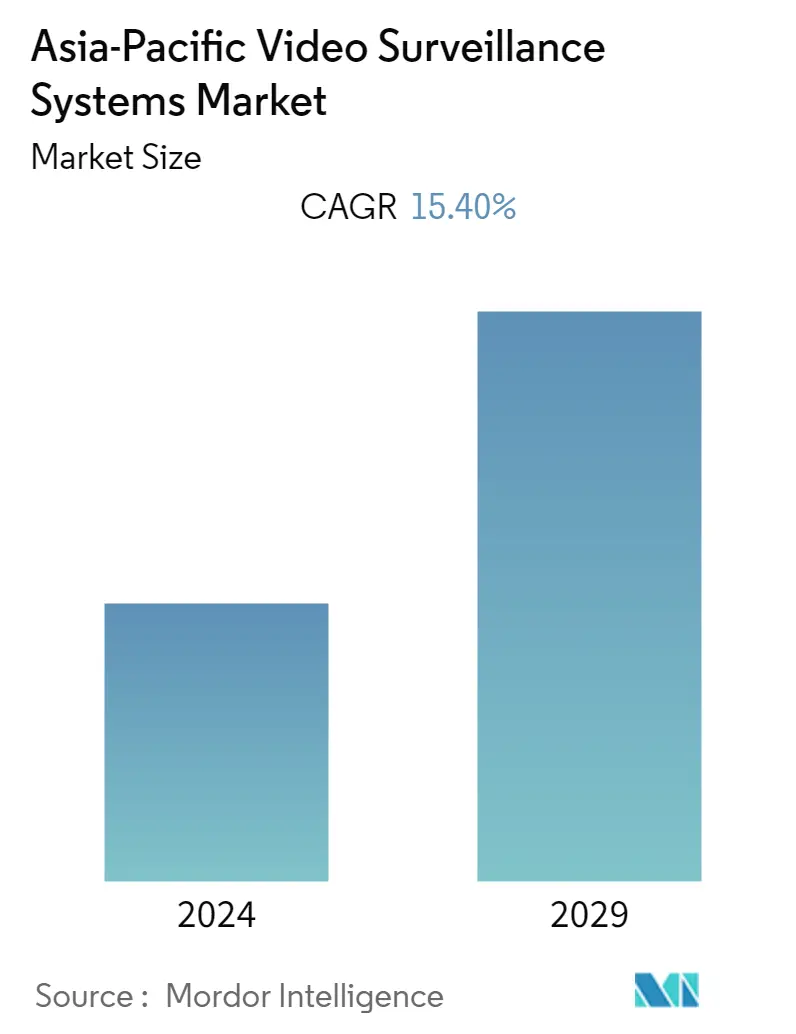Market Size of Asia-Pacific Video Surveillance Systems Industry

| Study Period | 2019 - 2029 |
| Base Year For Estimation | 2023 |
| Forecast Data Period | 2024 - 2029 |
| Historical Data Period | 2019 - 2022 |
| CAGR | 15.40 % |
| Market Concentration | Medium |
Major Players
*Disclaimer: Major Players sorted in no particular order |
Asia-Pacific Video Surveillance Systems Market Analysis
The Asia-Pacific Video Surveillance Systems Market is expected to grow at a CAGR of 15.4% during the forecast period (2022-2027). The Asia Pacific has emerged as one of the most significant markets in terms of video surveillance adoption, driven by heavy investments in infrastructure and smart city projects in different countries in the region.
- This region is witnessing the rising adoption of IP surveillance systems by governments of many APAC countries to prevent crimes in those regions. For instance, in August 2021, Singapore announced that it aims to have more than 200,000 police cameras by 2030, which is over double the current number of cameras deployed across the country, as they have proven useful in deterring crimes and locating missing persons.
- AI-based surveillance techniques are gaining traction in the region, with many governments in the Asia Pacific region procuring advanced analytic systems, facial recognition cameras, and sophisticated monitoring capabilities. The use of AI in video surveillance can provide significant benefits in detecting unusual incidents and generating alerts.
- Further, the usage of surveillance technology has become more prevalent in the pandemic era. Many countries in the Asia Pacific region have deployed mass surveillance tools like drones or closed-circuit television (CCTV) cameras for contact tracing, monitoring of quarantined individuals, and managing the overall transmission of COVID-19.
- Due to the COVID-19 pandemic, many end-use verticals deploying video surveillance systems have been affected by this crisis. As such, the market in 2020 experienced a decline 2019. Market players have witnessed supply chain disruptions for video surveillance equipment across both demand and supply sides.
- With advances in technology, most video surveillance devices, like IP security cameras, are connected to the internet and are thus at the risk of being hacked, which acts as a market restraint.
Asia-Pacific Video Surveillance Systems Industry Segmentation
A video surveillance system is a network of cameras, display units, and recorders used to monitor people, facilities, or places from a distance. Video surveillance is a useful and economical method to ensure the security of people, buildings, and valuables.
The Asia-Pacific Video Surveillance Systems Market is Segmented by Component (Hardware, Software, Video as a Service), by End-User (Commercial, Industrial, Residential, Government), and by Country (China, India, Japan, South Korea, Rest of Asia Pacific). All market estimates presented in the report are the most recent findings and estimates of the market and are adjusted as per COVID-19 impact on the market studied.
| By Component | ||||||||
| ||||||||
| ||||||||
| Video as a Service (VSaaS) |
| By End-User | |
| Commercial | |
| Infrastructure | |
| Institutional | |
| Industrial | |
| Defense | |
| Residential |
| By Country | |
| China | |
| India | |
| Japan | |
| South Korea | |
| Rest of Asia-Pacific |
Asia-Pacific Video Surveillance Systems Market Size Summary
The Asia-Pacific video surveillance systems market is experiencing significant growth, driven by substantial investments in infrastructure and smart city initiatives across the region. The adoption of IP surveillance systems is on the rise, with governments implementing these technologies to enhance security and crime prevention. The integration of AI-based surveillance techniques, such as facial recognition and advanced analytics, is gaining momentum, offering improved incident detection and alert generation. The pandemic has further accelerated the use of surveillance technologies for public health monitoring, although it also led to supply chain disruptions and market challenges in 2020. Despite these hurdles, the market is poised for recovery and expansion, with hardware components, particularly high-resolution cameras, playing a pivotal role in this growth.
China stands out as the largest market within the region, boasting an extensive surveillance network powered by advanced facial recognition software. Major global providers like Hikvision and Dahua are key players, driving the adoption of AI-based solutions worldwide. The market is characterized by moderate competition, with companies engaging in strategic partnerships and acquisitions to strengthen their market position. Innovations such as AI-enhanced cameras and cloud storage solutions are being introduced to meet evolving security needs. The focus on advanced technologies and strategic collaborations is expected to sustain the market's growth trajectory, as companies continue to enhance their offerings and expand their reach across the Asia-Pacific region.
Asia-Pacific Video Surveillance Systems Market Size - Table of Contents
-
1. MARKET INSIGHTS
-
1.1 Market Overview
-
1.2 Industry Attractiveness-Porters 5 Force Analysis
-
1.2.1 Bargaining Power of Suppliers
-
1.2.2 Bargaining Power of Consumers
-
1.2.3 Threat of New Entrants
-
1.2.4 Intensity of Competitive Rivalry
-
1.2.5 Threat of Substitutes
-
-
1.3 Industry Value Chain Analysis
-
1.4 Impact of COVID-19 Outbreak on the Industry
-
-
2. MARKET SEGMENTATION
-
2.1 By Component
-
2.1.1 Hardware
-
2.1.1.1 Camera
-
2.1.1.1.1 Analog
-
2.1.1.1.2 IP Cameras
-
2.1.1.1.3 Hybrid
-
-
2.1.1.2 Storage
-
-
2.1.2 Software
-
2.1.2.1 Video Analytics
-
2.1.2.2 Video Management Software
-
-
2.1.3 Video as a Service (VSaaS)
-
-
2.2 By End-User
-
2.2.1 Commercial
-
2.2.2 Infrastructure
-
2.2.3 Institutional
-
2.2.4 Industrial
-
2.2.5 Defense
-
2.2.6 Residential
-
-
2.3 By Country
-
2.3.1 China
-
2.3.2 India
-
2.3.3 Japan
-
2.3.4 South Korea
-
2.3.5 Rest of Asia-Pacific
-
-
Asia-Pacific Video Surveillance Systems Market Size FAQs
What is the current Asia-Pacific Video Surveillance Systems Market size?
The Asia-Pacific Video Surveillance Systems Market is projected to register a CAGR of 15.40% during the forecast period (2024-2029)
Who are the key players in Asia-Pacific Video Surveillance Systems Market?
Hanwha Techwin, Hangzhou Hikvision Digital Technology Co., Ltd., Zhejiang Dahua Technology Co., Ltd., Zhejiang Uniview Technologies Co., Ltd. and Vivotek Inc. are the major companies operating in the Asia-Pacific Video Surveillance Systems Market.

